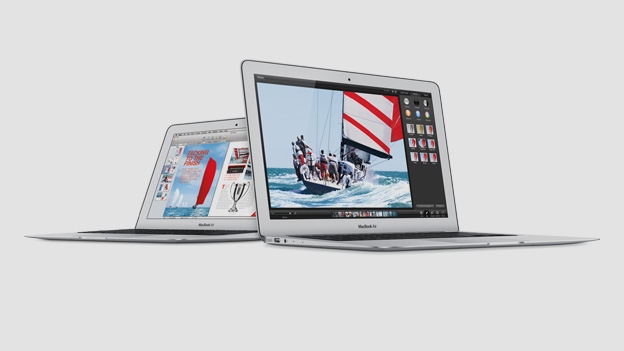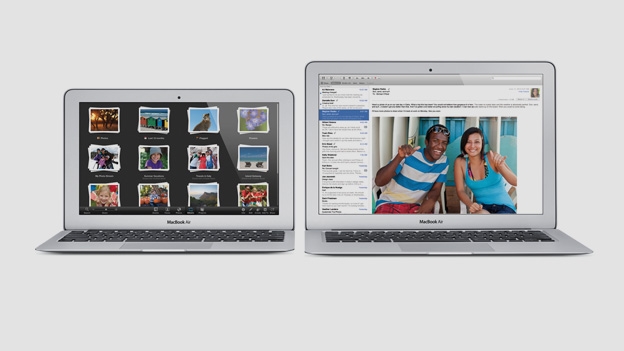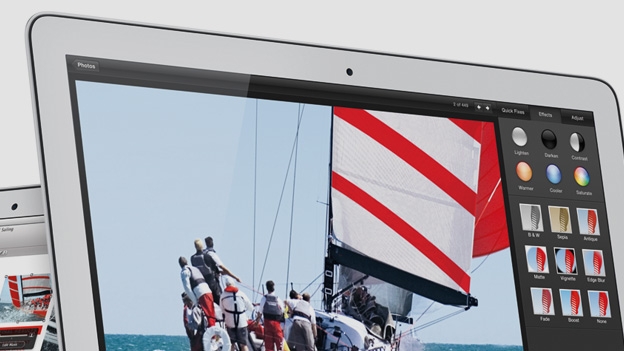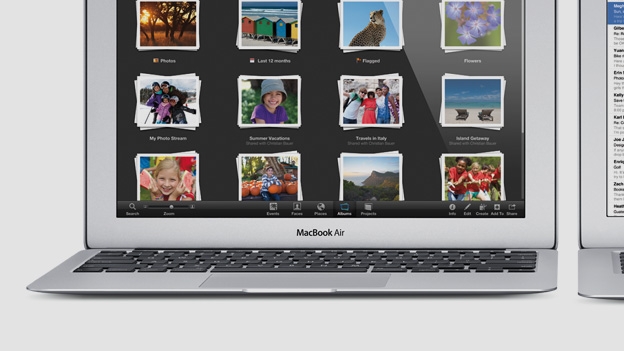MacBook Air 2013 (11-inch) review
No Retina screen, but an incremental upgrade to an already brilliant laptop


-
+
Improved battery life
-
+
Faster
-
+
better Wi-Fi
-
+
Drop in price
-
-
Lack of Retina screen
-
-
No SDXC port
Why you can trust T3




The new Apple MacBook Air 2013 isn't a headline-grabbing upgrade. But, with targeted improvements, the world's best laptop just got better. And cheaper
Put the 2013 MacBook Air (MBA) next to the last three iterations of Apple's slimline wonder and you'd need an eye keener than a laser hawk to spot any difference.
In fact, the only external change since the MacBook Air 2012 is the array of dual-microphones on the left flank, replacing the single mic. Everything else is the same; unibody aluminium construction, FaceTime HD cam, Thunderbolt port, MagSafe 2 power connector, even the weight - 1.08kg. But this is no bad thing.
The 11-inch MacBook Air remains a pinnacle of laptop design, sporting a full-size keyboard yet being light enough to carry around all day, slimmer than a copy of T3 magazine and swanking a footprint not much bigger than an iPad.
It's no surprise that it adorns many a commuter lap and, if IT departments allow it, it's seen in many a business meeting. We've seen a few Ultrabooks attempt similar, and some are truly noteworthy – the Asus UX31 Zenbook and Dell XPS 13 – but with the Cupertino sheen the MBA continues to be a laptop built for the modern day. However, to see what's really changed, we need to go under the bonnet.
MacBook Air 2013 11-inch: Features
However, before we get into what's new, we'll just come out and say it: where was the Retina screen upgrade?
Ok, so battery performance could be compromised (we'll come onto that) by such a potentially energy-zapping display, but the inclusion of Intel's new Haswell ULT, with its low-power tendencies, should have been a match for any jump in screen drain. We're just so used to the pin-sharp resolutions of the iPhone 5, iPad 4 and the latest MacBook Pros, see.
Nevertheless, standout improvements here are Apple's claimed 'all-day' battery life (see below), Intel's fourth-gen Intel HD Graphics 5000, faster RAM (now LPDDR3, expandable to 8GB), two USB 3.0 ports and the latest 802.11ac Wi-Fi adapter. All of which we've seen on various Windows-based laptops.
Get all the latest news, reviews, deals and buying guides on gorgeous tech, home and active products from the T3 experts
The aforementioned dual-mic tech is also nothing new to the world of laptops but is a welcome addition to the new MBA line, improving speech clarity by reducing background noise. It's a marked improvement when using Skype or FaceTime.
Our MBA came with OSX Mountain Lion rather than the impending Mavericks, expected later this year. As for backlit keys, Bluetooth 4.0, iLife, stereo speakers and ambient light sensors, they're all correct and present on this latest iteration. An SDXC card slot only appears on the 13-inch version and ethernet lovers will still have to purchase a USB adapter for £25.
MacBook Air 2013 11-inch: Performance
With regards to processing power, the new MBA can be supplied with Intel's dual-core i3, i5 (1.3GHz) or i7 (1.7GHz) CPUs. The previous non-Haswell-sporting gen started at i5 (1.7GHz) and ran to i7 (2.0GHz). Our model was a 1.3GHz Intel Core i5 with 4Gb of 1600MHz DDR3 RAM running OSX Mountain Lion and it zipped along. With a 256Gb SSD keeping the system quick and cool (128Gb comes as standard), the new MBA zipped along.
Apple claims that its latest flash storage is 45 per cent faster than the previous-generation MBA. In our real-world testing (employing both general and hardcore tasks over a week), we'd say performance times were slashed by milliseconds rather than seconds, but it's definitely faster to 'wake' after flipping the lid open from standby.
With the passage of time (and constant addition/removal of files and apps) things will inevitably start to slow, but even when loading the system with 150Gb of 'stuff', large files were transferred and loaded in a flash and even processor-hungry programs such as our image-heavy iPhoto ran smoothly.
The most noticeable improvement was with its Wi-Fi capability. Now running the 802.11ac standard and using the new 802.11ac/beamforming-toting Airport Extreme, we experienced a much more stable, quicker wireless connection at longer distances than the previous-gen MBA.
Interestingly, while the four-bar Wi-Fi connection icon remained at full strength on both new and old MBAs, the actual delivery of data was far quicker on the new model. Safari remained lightning quick and we could AirPlay non-stuttery content from one end of a 100ft garden to the living-room based Apple TV. Good for garden parties, we guess.
Apple claims the new Intel HD Graphics 5000 can push polygons 40 per cent faster than the last model. We tested a variety of HD video content – up to 1080p – and games to find a slightly smoother experience than before, but not wildly different from what we've been used to for the last year.
The brace of USB 3.0 ports also offers much faster file transfer, ramping up speeds to a 'theoretical' 5Gbps. In practice, it owns USB 2.0, with Thunderbolt zooming along even faster. You just need the peripherals to match.
Put alongside the similarly priced 13-inch MacBook Pro, most users probably won't see a performance difference (apart from the Retina screen), which is remarkable considering the MBA's size. It also seems to run a bit cooler than the last MBA.
MacBook Air 2013 11-inch: Screen
As aforementioned, the 11.6-inch LED-backlit, 16:9, 1366x768-res screen hasn't changed since 2010, but the graphics have. The Intel HD Graphics 5000 can support dual display (2560x1600 resolution on an external monitor) and mirroring to an Apple TV.
When OS X Mavericks arrives, with its improved mirroring features, this graphics upgrade will really come into its own. Screen output is controlled via Thunderbolt – HDMI only appears on the MacBook Pro range.
Pumped all the way up, brightness copes with all-but-nuclear light conditions and colours are rich. It just lacks the crispness and vivaciousness of the Retina screens we're all becoming used to.
With iOS 7's colourific design appearing on iPhones and iPads in the next few months, the MBA's screen might look even more flat. Viewing angles are what they were – not bad for such a small laptop, but only really designed for one-person-straight-on use.
MacBook Air 2013 11-inch: Battery
At the WWDC 2013 Keynote, the MBA's main feature upgrade was centred around battery life. Having a decent tank for most of the day will be essential for those who require a portable laptop lifestyle, so to hear Phil Schiller announce the new models with capacity to run for an entire day before needing a re-juice was impressive.
Apple says the 11-inch model can now last for nine hours as opposed to five, with eight-hours' iTunes playback and 30-day standby time. We didn't have chance to test the latter, but were impressed with the claims, eking out around seven hours of 'casual' use (web browsing, emailing, typing) and just over six hours movie playback.
Of course, a multitude of factors will influence these figures; up the ante in terms of screen brightness, device charging, wireless connection, visually demanding websites/applications and the power will drain much quicker.
But it's still formidable for a laptop of this size and power. As a portable work tool, or power-less companion to a long flight/commute, it's still at the top of its game. Little we've seen compares to it.
MacBook Air 2013 11-inch: Verdict
So, an incremental upgrade to the previous model. We've seen Apple do this before (iPhone 4 to 4S) – the difference here being an increase of performance and a drop in price - the new 11-inch MBA starts at £849. We're disappointed rather than annoyed that Retina didn't find its way into this iteration and think that if you have the last MacBook Air, it's not worth upgrading just yet.
However, in performance terms, it's comparable if-not-better than its heftier 13-inch MacBook Pro cousin. In short, we've come away thinking that the world's best laptop just got better. When OSX Mavericks is available for (a presumable) upgrade later in the year, introducing more portable iCloud features, it might make the decision for those teetering on the Windows 8/Mac fence much easier.
MacBook Air 2013 11-inch release date: Out now
MacBook Air 2013 11-inch price: Model tested £1029. From £849